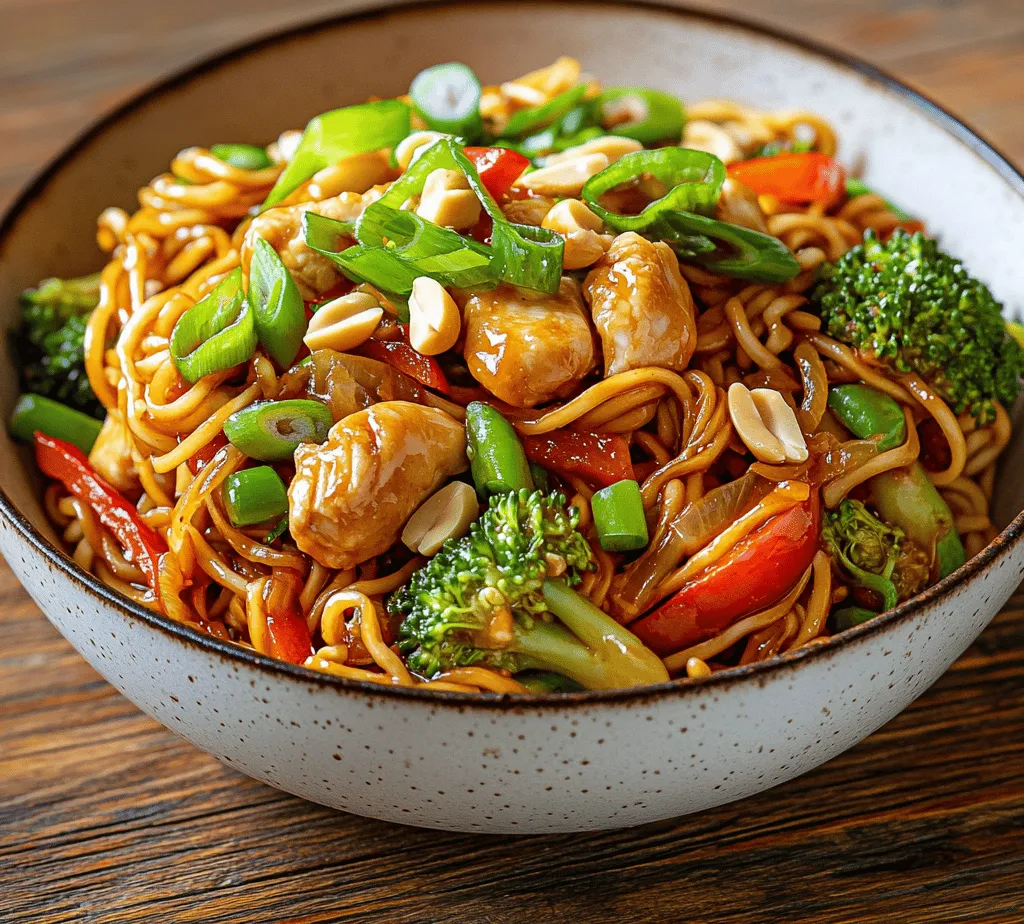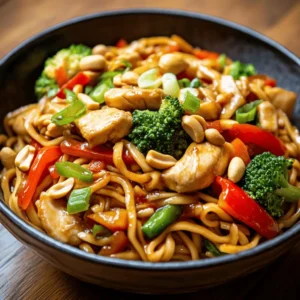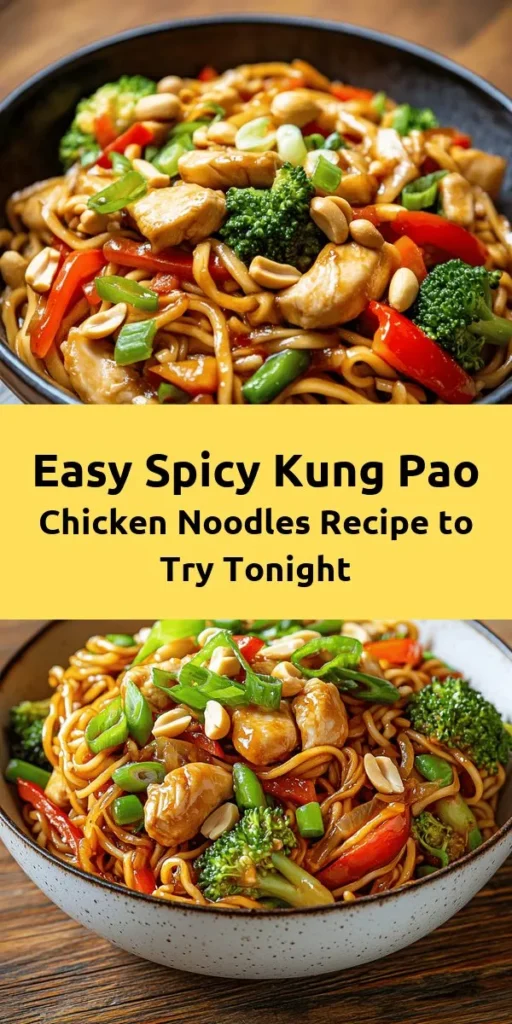The culinary world is filled with dishes that not only tantalize your taste buds but also bring a sense of comfort and satisfaction. One such dish is the Spicy Kung Pao Chicken Noodles, a delightful fusion that combines the bold flavors of traditional Kung Pao Chicken with the satisfying texture of noodles. This recipe takes the classic elements of Kung Pao, known for its spicy, sweet, and savory notes, and elevates it to new heights by incorporating stir-fried noodles, making it perfect for those who crave a hearty meal.
Kung Pao Chicken has long been a staple in Asian cuisine, originating from the Sichuan province of China. Its popularity has transcended borders, becoming a favorite in Chinese restaurants worldwide. The dish is celebrated for its distinctive combination of tender chicken, crunchy peanuts, and a medley of vegetables, all enveloped in a rich, spicy sauce. By adding noodles to the mix, this recipe not only enhances the flavor profile but also transforms the dish into a complete meal that can serve as a quick weeknight dinner or an impressive centerpiece for special occasions.
The appeal of Spicy Kung Pao Chicken Noodles lies in its versatility and ease of preparation. Whether you are cooking for yourself, your family, or guests, this dish delivers a satisfying and flavorful experience that is sure to please. With an array of textures and the perfect balance of heat, sweetness, and umami, this recipe promises to leave everyone craving more.
Understanding the Ingredients
Creating a successful Spicy Kung Pao Chicken Noodles dish requires quality ingredients that work harmoniously to produce a burst of flavors. Here’s a closer look at the key components that make this recipe stand out.
Chow Mein Noodles
Chow Mein noodles are the backbone of this dish, providing a chewy texture that absorbs the rich flavors of the sauce. Made from wheat flour, these noodles are typically parboiled before being stir-fried, allowing them to develop a slightly crispy exterior while remaining tender on the inside. Their ability to soak up the savory and spicy sauce makes them an ideal choice for this recipe. When cooked properly, Chow Mein noodles add a delightful contrast to the juicy chicken and crisp vegetables, ensuring a satisfying bite every time.
Chicken Breast
As the primary source of protein in this dish, chicken breast is favored for its lean qualities and versatility. It cooks quickly and absorbs flavors beautifully, making it a popular choice in many Asian recipes. In this Kung Pao variation, the chicken is coated with cornstarch before cooking, which not only helps to create a crispy exterior but also locks in moisture, resulting in tender and juicy pieces. This preparation method elevates the overall texture of the dish, ensuring that each bite is packed with flavor.
Vegetables
To balance the richness of the chicken and noodles, a variety of fresh vegetables are incorporated into the dish. Broccoli and bell peppers are standout choices, both offering their own nutritional benefits. Broccoli is an excellent source of vitamins C and K, as well as dietary fiber, while bell peppers add a sweet crunch and vibrant color. Together, these vegetables not only enhance the dish’s visual appeal but also provide a satisfying crunch that complements the other ingredients. Adding vegetables to the mix boosts the nutritional value, making this dish a well-rounded meal for any occasion.
Flavor Enhancers
The magic of Spicy Kung Pao Chicken Noodles lies in its flavor profile, crafted through a combination of aromatics and sauces. Garlic and ginger are essential components, each contributing their distinct characteristics to the dish. Garlic infuses a pungent, savory depth, while ginger adds a fresh, zesty kick that brightens the overall flavor.
The sauce itself is a crucial element, typically made with soy sauce, rice vinegar, and a hint of sugar to achieve the perfect balance of salty, tangy, and sweet. To build upon the authentic Kung Pao flavor, you may also include hoisin sauce and chili paste, which introduce additional layers of complexity and heat. This combination of ingredients creates a bold and irresistible sauce that clings to the noodles, chicken, and vegetables, ensuring every bite is bursting with flavor.
Preparation Steps
Now that we’ve explored the essential ingredients, it’s time to dive into the preparation process for Spicy Kung Pao Chicken Noodles. Following these steps will ensure that you achieve the perfect balance of flavors and textures.
Cooking the Chow Mein Noodles
Begin by cooking the Chow Mein noodles according to the package instructions. It’s crucial to not overcook the noodles, as they should maintain a firm texture that can stand up to stir-frying. Once cooked, drain the noodles and rinse them under cold water to halt the cooking process. This step also helps to prevent them from sticking together during the stir-frying phase. Set the noodles aside while you prep the chicken and vegetables.
Preparing the Chicken
For the chicken, start by cutting the chicken breast into bite-sized pieces. This not only allows for quicker cooking but also ensures that the chicken absorbs the flavors of the marinade. To enhance the texture, coat the chicken pieces with a thin layer of cornstarch. This technique will create a delightful crispy crust when stir-fried, resulting in a contrast to the tender interior.
Next, marinate the chicken in a mixture of soy sauce, rice vinegar, and a dash of sesame oil for at least 15 minutes. This not only infuses the chicken with flavor but also helps to tenderize the meat. While the chicken is marinating, you can begin preparing the vegetables and sauce.
Making the Sauce
The sauce is the heart of the Spicy Kung Pao Chicken Noodles, and it’s important to get it just right. In a small bowl, combine soy sauce, hoisin sauce, rice vinegar, and sugar. For those who enjoy a spicy kick, incorporate chili paste or crushed red pepper flakes to taste. Mix these ingredients until the sugar dissolves, creating a well-balanced sauce that will coat the chicken and noodles beautifully.
As you prepare the sauce, consider the flavors of each ingredient. Soy sauce adds a salty umami base, hoisin sauce contributes a touch of sweetness and depth, while rice vinegar provides a tangy contrast. Adjust the ingredients according to your taste preferences; the beauty of this recipe lies in its adaptability. Once the sauce is ready, set it aside, and prepare to bring all the elements together in the stir-frying process.
Cooking Techniques
Stir-frying is the cooking technique that will bring your Spicy Kung Pao Chicken Noodles to life. This method is not only quick but also maximizes flavor, allowing the ingredients to retain their texture and nutritional benefits.
Stir-Frying Explained
Stir-frying involves cooking food quickly over high heat in a small amount of oil while continuously stirring. This technique is perfect for creating a harmonious blend of flavors while ensuring that the vegetables remain crisp and vibrant. The key to successful stir-frying is to prep all your ingredients beforehand, as the cooking process happens rapidly.
When ready to cook, heat a large wok or skillet over medium-high heat until it’s hot. Add a tablespoon of oil, swirling it around to coat the surface. When the oil shimmers, add the marinated chicken in a single layer, allowing it to sear and brown for a couple of minutes before stirring. This initial sear is crucial for developing flavor and ensuring a crispy texture.
Once the chicken is nearly cooked through, add in the vegetables, followed by the sauce. Stir-fry for a few more minutes until everything is combined and heated through. Finally, toss in the cooked Chow Mein noodles, ensuring they are well-coated in the flavorful sauce. This final mix will allow the noodles to absorb the sauce’s richness, creating a cohesive and delicious dish that is sure to impress.
As you master the art of stir-frying, remember to keep an eye on the heat, adjusting as necessary to avoid burning the ingredients. With practice, you’ll find the perfect balance that results in a restaurant-quality dish right in your kitchen.
By following these steps and understanding the key ingredients, you are well on your way to creating a mouthwatering Spicy Kung Pao Chicken Noodles dish that will be a hit on any dining table.

Layering Flavors
To truly achieve the vibrant and complex profile that defines Spicy Kung Pao Chicken Noodles, the order in which you add the ingredients is crucial. This method not only enhances the overall taste but also ensures that each component retains its unique characteristics.
Start by heating a tablespoon of vegetable oil in your wok or large skillet over medium-high heat. Once the oil is shimmering, add the marinated chicken pieces. Stir-fry the chicken until it’s browned and cooked through, which should take about 5-7 minutes. This initial phase builds the foundation of flavor, allowing the natural juices of the chicken to infuse the oil.
Next, it’s time to introduce your vegetables. Add the bell peppers, carrots, and any other vegetables you’re using, and stir-fry for another 3-4 minutes until they start to soften. This stage not only adds color to your dish but also layers in sweetness and crunch.
Finally, pour in the prepared Kung Pao sauce, ensuring that it coats all the ingredients evenly. Allow the mixture to bubble for a minute, letting the sauce thicken and mingle with the chicken and vegetables. This careful layering of flavors creates a well-balanced dish that highlights the individual tastes of each ingredient.
Combining Ingredients
Merging Noodles with Chicken and Vegetables
Now that you have a glorious medley of chicken, vegetables, and aromatic sauce, it’s time to incorporate the chow mein noodles. You can use either fresh or dried noodles, but if you opt for dried, ensure they have been cooked according to the package instructions and drained well.
Add the cooked noodles to your wok, using tongs or a spatula to gently toss them with the chicken and vegetables. It’s essential to mix everything thoroughly to ensure that the noodles absorb the spicy sauce, bringing a delightful flavor to every bite. You should aim for an even distribution, so each mouthful offers a harmonious blend of textures and tastes.
If you find the mixture too dry, consider adding a splash of low-sodium soy sauce or a few teaspoons of water to help loosen it up. This will help create a silkier texture, allowing the noodles to glide smoothly alongside the other ingredients.
Finishing Touches
As you prepare to serve your Spicy Kung Pao Chicken Noodles, don’t forget the garnishes that elevate this dish to the next level. Roasted peanuts add a satisfying crunch and a nutty flavor that complements the spiciness of the dish. Sprinkle a generous handful over the noodles before serving.
Additionally, finely chopped green onions lend a fresh, vibrant touch that enhances the dish’s overall appeal. Their mild onion flavor pairs beautifully with the richness of the chicken and the heat from the sauce. Garnish each serving with a sprinkle of green onions and peanuts just before presenting it to your guests.
Nutritional Information
Understanding the nutritional value of your meal can help you appreciate its health benefits. Here’s a breakdown of the nutritional content per serving of Spicy Kung Pao Chicken Noodles:
– Calories: Approximately 450-500 calories
– Protein: 30-35 grams
– Carbohydrates: 50-55 grams
– Fats: 15-20 grams
This dish offers a substantial amount of protein from the chicken, which is essential for muscle repair and growth. The variety of vegetables contributes dietary fiber, which aids digestion and keeps you feeling full. Additionally, peanuts provide healthy fats and protein, rounding out the nutritional profile of this dish.
While it is essential to enjoy flavorful meals, it’s equally important to consider balance. The combination of protein, healthy fats, and carbohydrates makes this dish satisfying and nutritious, ideal for lunch or dinner.
Serving Suggestions
To make your meal even more delightful, consider pairing your Spicy Kung Pao Chicken Noodles with some complementary side dishes. Here are a few ideas:
– Steamed Broccoli or Bok Choy: These vegetables provide additional nutrients and a fresh crunch that pairs well with the spicy noodles.
– Spring Rolls: Light and crispy, spring rolls can serve as a perfect appetizer to your main dish.
– Asian Slaw: A refreshing slaw made with cabbage, carrots, and a light sesame dressing can balance out the richness of the noodles.
For beverages, you can enhance your dining experience with:
– Jasmine Tea: Its fragrant aroma and delicate flavor make it an excellent accompaniment to the spiciness of the dish.
– Light Beer or Sake: Both beverages can complement the flavors of the Kung Pao sauce without overpowering them.
Cultural Significance
The origins of Kung Pao Chicken can be traced back to the Sichuan province of China. Traditionally, this dish features diced chicken stir-fried with peanuts and vegetables in a spicy, tangy sauce. Its namesake, Ding Baozhen, a late Qing dynasty official, is said to have popularized it, and it has since evolved into a beloved Chinese dish worldwide.
This recipe for Spicy Kung Pao Chicken Noodles represents a modern twist on traditional flavors, combining the classic elements of Kung Pao Chicken with the comforting texture of noodles. As culinary traditions continue to evolve, this dish exemplifies how we can adapt and reinterpret classic recipes while maintaining their essence.
Conclusion
Spicy Kung Pao Chicken Noodles is more than just a meal; it’s a celebration of flavor, culture, and the joy of cooking. With its vibrant colors, rich textures, and a perfect balance of spicy and savory elements, this dish is sure to become a favorite in your household.
Whether you’re cooking for family or entertaining friends, this recipe offers a delightful taste of Asian cuisine that’s both satisfying and impressive. Don’t hesitate to make this dish your own by adjusting the spice levels or incorporating your favorite vegetables.
Cooking is a wonderful way to bond with loved ones, and sharing a meal like Spicy Kung Pao Chicken Noodles can create lasting memories. Embrace the joy of preparing this flavorful dish at home, and discover how satisfying it can be to share a taste of your culinary creations with those you care about. Enjoy your cooking adventures!



